Melozzo da Forlì (1438-1494)
Get a Da Forlì Certificate of Authenticity for your painting (COA) for your Da Forlì drawing.
For all your Da Forlì artworks you need a Certificate of Authenticity (COA) in order to sell, to insure or to donate for a tax deduction.
Getting a Da Forlì Certificate of Authenticity (COA) is easy. Just send us photos and dimensions and tell us what you know about the origin or history of your Da Forlì painting or drawing.
If you want to sell your Da Forlì painting or drawing use our selling services. We offer Da Forlì selling help, selling advice, private treaty sales and full brokerage.
We have been authenticating Da Forlì and issuing certificates of authenticity since 2002. We are recognized Da Forlì experts and Da Forlì certified appraisers. We issue COAs and appraisals for all Da Forlì artworks.
Our Da Forlì paintings and drawings authentications are accepted and respected worldwide.
Each COA is backed by in-depth research and analysis authentication reports.
The Da Forlì certificates of authenticity we issue are based on solid, reliable and fully referenced art investigations, authentication research, analytical work and forensic studies.
We are available to examine your Da Forlì painting or drawing anywhere in the world.
You will generally receive your certificates of authenticity and authentication report within two weeks. Some complicated cases with difficult to research Da Forlì paintings or drawings take longer.
Our clients include Da Forlì collectors, investors, tax authorities, insurance adjusters, appraisers, valuers, auctioneers, Federal agencies and many law firms.
We perform Melozzo da Forlì art authentication, appraisal, certificates of authenticity (COA), analysis, research, scientific tests, full art authentications. We will help you sell your Melozzo da Forlì or we will sell it for you.
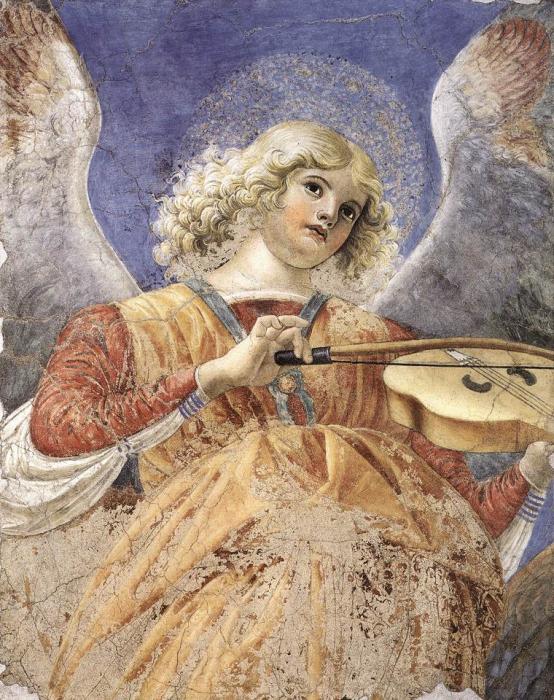
Melozzo da Forlì was an Italian Renaissance painter near the Umbrian school, the first who practised foreshortening with much success and one of the most outstanding fresco painters of 15th century. He was the most important member of the Forlì painting school.
Melozzo came, it is supposed, of a wealthy family named Ambrosi. Nothing is known about his early years, and it is only a hypothesis that he formed at the Forlìvese school of art (Forlì painting school), then ruled by Ansuino da Forlì, for they were both influenced by the Mantegna manner.
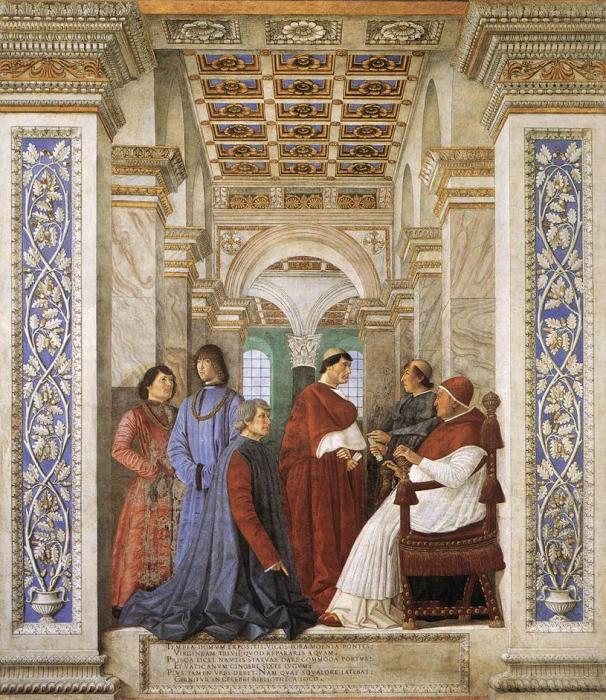
It has been said that he became a journeyman and color-grinder to some of the best masters, in order to prosecute his studies; this lacks confirmation. His presence his first mentioned in his birthplace in 1460 and again in 1464. Around this period, together with Antoniazzo Romano, frescoed the Bessarione chapel in the basilica dei Santi Apostoli in Rome. Melozzo presumably moved to in Urbino between 1465 and 1475: here he met the highly theoretical and mathematical Piero della Francesca, who profoundly influenced the Melozzo’s style and use of perspective. He should have also studied the architectures by Bramante and other Flemish painters then working for the duke Federico da Montefeltro: perhaps Melozzo worked with Justus of Ghent and Pedro Berruguete to the decoration of the studiolo of the famous Ducal Palace of the city.
In 1475 Melozzo transferred to Rome, though some authorities claim his presence in Rome ten (or five?) years earlier to work in the Basilica di San Marco. In 1477 he finished his first major work in the new seat, a fresco now transferred to canvas and placed in the Pinacoteca Vaticana, representing the appointment of Bartolomeo Platina by Sixtus IV as librarian of the restored Vatican Library. In 1478 he was one of the original members of the academy of St Luke, founded by Sixtus IV to unite the main painters working in the city.
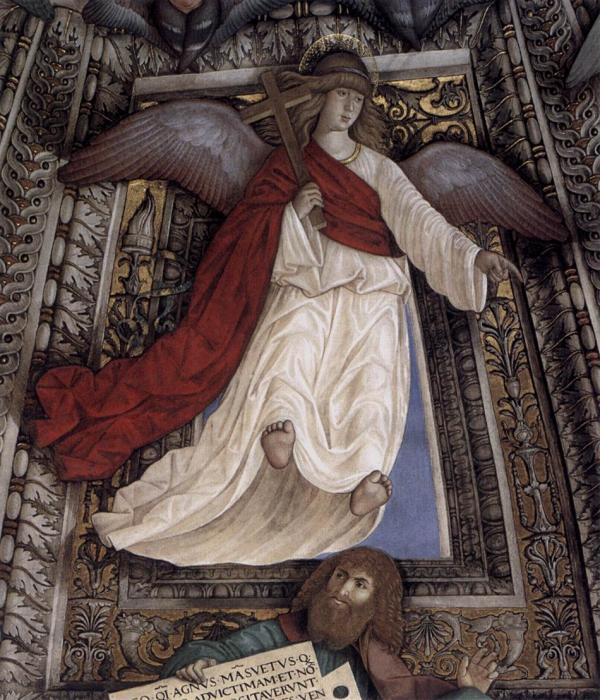
About 1480 Melozzo was commissioned by Pietro Riario to paint the vault of the apse in the basilica dei Santi Apostoli in Rome, his subject being the Ascension. The figure of Christ is so boldly and effectively foreshortened that it seems to “burst through the vaulting”; this fresco was taken down in 1711, and the figure of Christ is now in the Quirinal Palace; while some of the other portions, almost Raphaelesque in merit, are in the sacristy of St Peter’s: a hall in the Vatican Museums is designed for angels and apostles by Melozzo taken down the same fresco.
Another work of the Roman period is an Annunciation that can still be seen in the Pantheon.
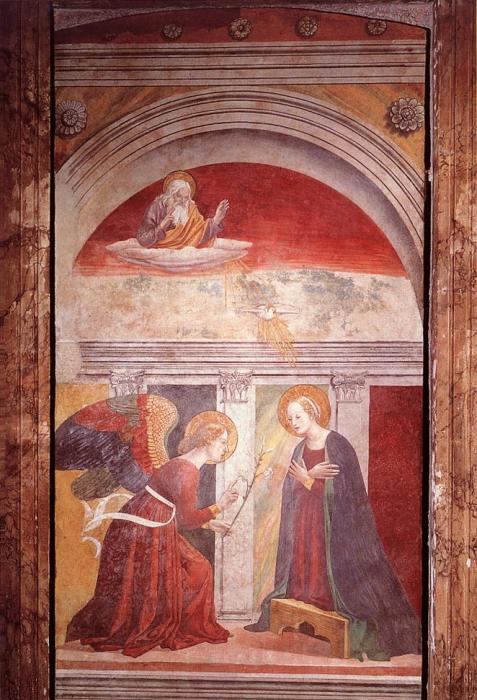
Melozzo’s last work in Rome is a chapel, now destroyed, in the church of Santa Maria in Trastevere. After the death of Sixtus IV in 1484 he moved from Rome to Loreto. Here he painted the fresco in the cupola of San Marco’s sacristy in the basilica della Santa Casa, commissioned by cardinal Girolamo Basso della Rovere. It is one of the first examples of a cupola decorated both with architectures and figures, with a profound influence from the Camera Picta by Mantegna.
In 1489 Melozzo returned in Rome. In this second period he probably drew some cartoons for the mosaics of Jesus blessing in the St. Helen chapel of the basilica of Santa Croce in Gerusalemme.
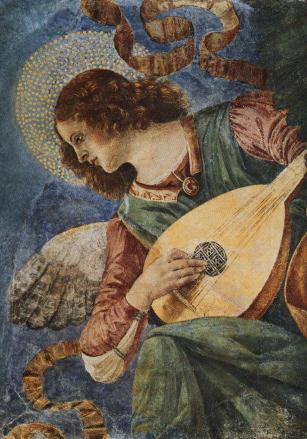
Melozzo also painted the cupola of the Capuchin church at Forlì, destroyed in 1651; and it has been said that he executed at Urbino some of the portraits of great men (Plato, Dante, Sixtus IV, etc.) which are now divided between the Barberini Palace and the Campana collection in Paris. In 1493 he worked to some ceilings of the Palazzo Comunale of Ancona, which have gone lost. Eventually Melozzo moved to Forlì, where, together with his pupil Marco Palmezzano, decorated the Feo Chapel in the church of San Biagio, which was destroyed during World War II. The Pinacoteca of Forlì houses a fresco by Melozzo, termed the “Pestapepe”, or Pepper-grinder, originally painted as a grocer’s sign; it is an energetic specimen of rather coarse realism, now much damaged. It’s the only non-religious subject by Melozzo. Melozzo died in November 1494 in Forlì.
While few of Melozzo’s works have been preserved until today, critics agree he contributed sensibly to the progress of pictorial art; and, without being remarkable as a colorist, gave well graded lights, with general care and finish, and fine dignified figures. His works bear a certain resemblance to those of his contemporary Mantegna. Marco Palmezzano was his pupil; and the signature “Marcus de Melotius” on some of Palmezzano’s works, along with the general affinity of style, has led to their being ascribed to Melozzo, who has hence been incorrectly called “Marco Melozzo”.
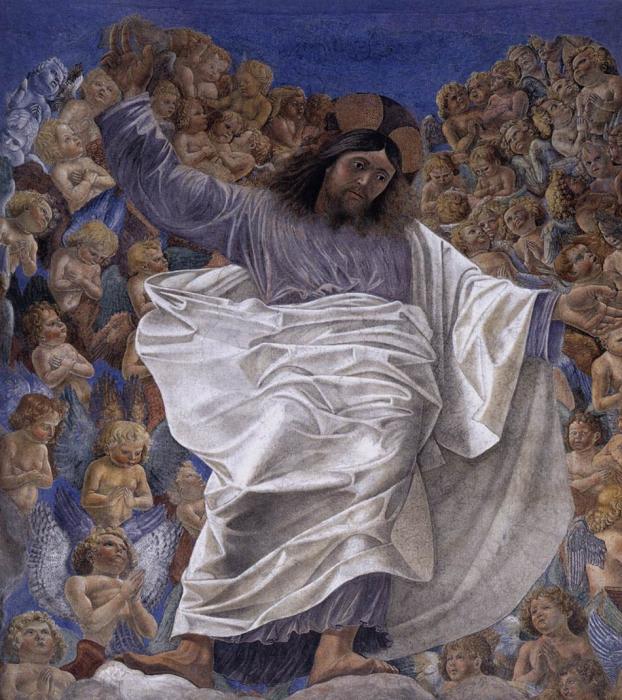
Still wondering about an Italian painting in your family collection? Contact us…it could be by Melozzo da Forlì.
